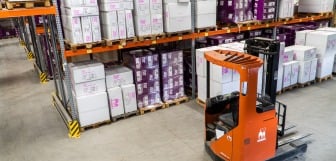How to Manage Inventory in a Retail Store
When working in retail, it comes as no surprise that one of the most important areas to keep track of is inventory. Organising your stock can save you time, maintain your margins, and keep your store neat in more ways than one. However, with so many options available to so many different retailers, it can be difficult to know which one is right for your business.
But don't fold... we've compiled a list of top tips to help you take care of cataloguing your company. So read below to explore the importance of inventory management to a retail business, and get a masterclass on making inventory management easy.
What is retail inventory management?
Before learning how to master this powerful process, it's important to define retail inventory management.
In the process of tracking inventory levels, sales, and order history, retail inventory management encompasses methods for optimising stock levels to minimise cost while maximising customer satisfaction. In other words, it’s all about finding the perfect balance between too much and too little inventory.
Why is retail inventory management important?
There are several reasons why retail inventory management is important. Firstly, it helps your business avoid stock shortages, which can lead to lost sales and unhappy customers. If you're unable to fulfil a product or promise of its return in a decent time frame, you will lose valuable customers, as well as traction around your product, since 8% of all online sales are completely abandoned due to out of stock items.
Secondly, having an effective inventory system for retailers helps prevent overstocking, which ties up valuable capital in inventory that could be better used elsewhere. You wind up with less deadstock, and can easily figure out which products are connecting with your consumers, which allows you to buy selectively, and only purchase additional inventory that you know will make a profit.
Finally, effective retail inventory management can help you to make more informed decisions about your product selection, pricing, and promotions.
How can I improve my retail inventory management?
Although every store is different, whether you're selling suits or surfboards, it’s crucial to have a retail inventory strategy in place. There are some simple steps every retail business owner can take, to improve retail inventory management:
 Audit your stock
Audit your stock
When handling stock in retail, even with the help of inventory management software, it's still important to regularly audit your inventory, to make sure what you actually have matches what you think you do. Businesses may use a variety of inventory-taking methods, including an annual, year-end physical count that counts every item and frequent spot-checking, which is particularly useful for items that are moving quickly or have stocking difficulties.
You might be wondering exactly how to take inventory in a retail store. Your audit should include particular details about your stock such as the individual product name, product category, size (if applicable), retail price, location, wholesale cost and expiration date and more.
Knowing exactly what you have in stock will help you avoid overordering and losing money on products that go out of fashion or become damaged.
Get the low-down on location
If you are a small or one-store business, pinning down your inventory’s location is no sweat, as your products are most likely displayed throughout your store or sitting in the stockroom.
However, distribution centres, warehouses, split stockrooms, and store shelves are all potential inventory storage areas for the stock of bigger retail businesses, with multiple sites or omnichannel retailers. Locations within these areas become more specific, including information like an item's section and shelf. In these cases especially, products that are put back in the wrong place or disregarded, result in lost sales and income.
The use of barcodes and labels that contain category codes to automate the mapping of your inventory is just one of many inventory management methods that can help prevent this from happening.
Process your promotions
Sales may fall short for a variety of reasons, such as a toppling trend, or seasonal fluctuations. Be meticulous with your markdowns, and focus your strategy on moving slow sellers so that you can generate money and make way for far more successful stock.
You should create a forecast ahead of time for discounts, by evaluating past data and understanding your customer’s purchasing habits, this ensures you have a steady supply on hand.
Ditch the dead-weight
Excess inventory can weigh heavy on your profitability, by tying up your company's capital. 'Deadstock' refers to imperfect items, delivery errors and excess stock products from previous seasons.
To begin, make a list of products that fall into this category and remove them from your inventory. Set aside an area to store dead stock and handle it on a regular basis (this could be weekly or monthly).
Returnable items should be shipped back to vendors for credit as quickly as possible. In order to do this successfully, you must keep track of any resending deadlines. Damaged and defective products should also be sent back to the supplier.
You can deal with any more excess, by selling to independent merchants, giving away donations, recycling (which is always the preferred option), or disposing of it appropriately depending on your respective line of business.
Use retail store inventory software
Inventory management software can help you automate and keep track of your inventory, whether you have a brick-and-mortar shop or an online store. With the help of inventory software, retail stores can track also track sales data and develop a sales history for each individual product.
There are a number of different inventory management software programs available, so it's important to choose one that's right for your business. Some factors you may want to consider include the size of your inventory, the number of locations you have, and whether you need features such as barcode scanning or integration with accounting software.
Happy returns
If there's one aspect of inventory management that'll affect your returns... it's returns.
Without a method in place for dealing with customer returns, you run the danger of holding unsellable products or missing out on a marketable item's return to display.
When a customer returns an item, check for any defects or damage before sending it back and decide to either send it for repair, write it off or return it to the supplier respectively. If the item can be sold, add it to your inventory counts and return it to its specific location (in a brick-and-mortar store, online inventory, etc.).
All fingers point to reordering
Retailers can use sales data and the time it takes for goods to arrive from vendors, to calculate the ‘reorder point,' or the 'inventory threshold' that should trigger reordering. The formula presents as: (Average daily unit sales x average lead time in days) + safety stock in units = reorder point in units.
Access all things inventory, with an award-winning POS system
With Epos Now's complete retail POS system, getting muddled over business inventory management is so last season. Point of Sale (POS) systems work as the backbone of retail businesses for a number of reasons. Our POS systems are designed with retailers in mind and can provide successful solutions to all points covered previously.
Designed to offer complete business management, our systems allow you to receive detailed analysis on the areas that matter to your business. You can control all vital aspects of your company from one cloud-based system, as well as:
- Multi-award-winning inventory management software that syncs online sales and in-person sales for the most up-to-date stock levels
- Create your own website or integrate with a fully loaded e-commerce platform
- Automatic order purchasing once stock once it falls below a certain level to manage inventory costs.
- Filter sales reports by individual product, profit margin, trending items, or employee
We let you choose the tools and insights to help your large or small business achieve its goals.
If you're still keen to start taking stock of your inventory, we'd love to hear from you!




